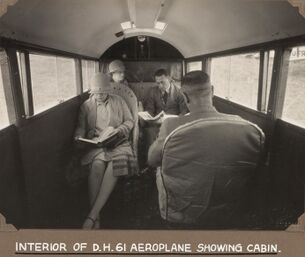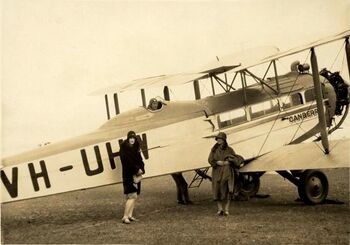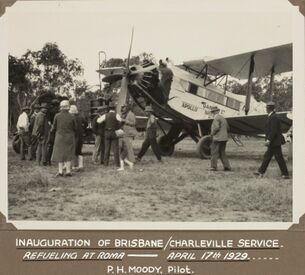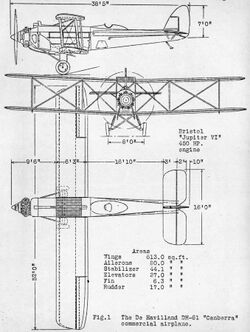Engineering:de Havilland Giant Moth
The de Havilland DH.61 Giant Moth was a 1920s United Kingdom large single-engined biplane transport built by de Havilland at Stag Lane Aerodrome, Edgware. Intended primarily for use in Australia, a number were also shipped to Canada.
Design
Following the success of the de Havilland DH.50J in Australia, the company was asked to design a larger replacement using a Bristol Jupiter engine. The cabin had room for six to eight passengers with the pilot in an open cockpit behind the wings. The aircraft took only 10 weeks to design and the prototype first flew in December 1927. A total of 10 aircraft were built, including one in Canada built from components, with the rest coming from the Stag Lane production line.
A Pathé News clip claims it was the "first commercial plane with folding wings!" and shows a single man folding them.[1]
Operational history
Australia and New Guinea
Following test flights in England, the aircraft was sent to de Havilland Australia in Melbourne. After reassembly, the prototype first flew on 2 March 1928 and was used on scheduled services between Adelaide and Broken Hill by MacRobertson Miller Aviation. The prototype was originally called Canberra, which was used as a type name until it was changed to Giant Moth.[2]
Another (registration G-AUHW) followed in November 1928, but crashed at Cowes, Victoria, before it was delivered to the purchaser, Airgold Ltd.[3] After repairs, it was bought by Les Holden in 1928 for his charter service, based in Mascot, New South Wales.[4] He christened her Canberra.[4] Already a World War I flying ace, he (and Canberra) would be in the news the next year.
In 1929, Australian aviation pioneers Charles Kingsford Smith and Charles Ulm set out on a Fokker F.VII trimotor monoplane named Southern Cross from Sydney for England. When radio contact was lost, a search was organised. In April 1929, Australian National Airways[5] or the Sydney Citizens' Relief Committee[4] engaged Holden to join the search. Simply getting to the area was difficult. Before the flight from Sydney to Wyndham, an extra 70-gallon petrol tank and a radio were installed.[6] Even with the additional tank, Holden had to stop and find petrol and oil along the way.[7] On 4 or 5 April 1929, Holden, Aero Club ground engineer F. R. Mitchell, Dr. G. R. Hamilton and wireless operator L. S. W. Stannage set out aboard Canberra.[7] According to one newspaper article, Holden flew a total of 9000 miles (14,500 km) and was in the air for 100 hours,[8] before spotting the missing aircraft on a mud flat near the Gleneig River.[9] The crew of Southern Cross were rescued, though two other searchers lost their lives.
QANTAS acquired two Giant Moths, Apollo (G-AUJB) and Diana (G-AUJC), in April[10] and May 1929, respectively.[11] They were the first QANTAS aircraft equipped with toilets.[12] The airline took them out of service in 1935 because the Bristol Jupiter XI engines were unreliable.[12] Apollo was sold that year and crashed near Mubo, New Guinea, on 9 May 1938.[10]
Canada
Three aircraft for Canada (G-CAPG), (G-CARD) and (G-CAJT) were fitted with Short Brothers floats at Rochester before one was delivered to Canadian Vickers. This aircraft (G-CAJT) was sent to Western Canada Airlines Ltd. on a rental arrangement. During a proving flight on 23 October 1928, the Giant Moth suffered structural damage in the air and crashed at Calgary, Alberta in a non-fatal accident.[13] The other DH.61s continued to fly in Ontario in fire-fighting operations. One Giant Moth (CF-OAK) was modified from parts and flew with a Pratt & Witney Hornet engine.[14]
United Kingdom
Geraldine (G-AAAN) was bought by the Daily Mail to carry a photographer and his motorcycle around the United Kingdom.[15] The aircraft would land at the nearest airfield to the story. This aircraft was also equipped with a dark room to enable the photographs to be developed on the return journey.[15] Later, it was sold to National Flying Services and renamed Leone.[15] Western Australian Airways acquired it in the early 1930s; it served Western Australia from 1931 to 1935.[15][16] When the airline encountered financial difficulties, the Giant Moth was sold to New Guinea Airlines.[17] G-AAAN crashed on 20 August 1935, while landing at Wau, New Guinea.[17]
Youth of Britain (G-AAEV), modified to carry 10 passengers, was used by Sir Alan Cobham in an aviation promotional tour of the United Kingdom lasting 21 weeks and ending on 7 October 1929.[18] Cobham flew 60,000 miles (97,000 km), visited 110 towns and took aloft 40,000 passengers, including 10,000 schoolchildren free of charge.[18] Among those who experienced their first flight in Cobham's Giant Moth was Eric Lock, who became a Royal Air Force fighter ace during the Battle of Britain.[19] After the tour, Cobham sold the Giant Moth to Imperial Airways, to be used for survey flights. Its use was short-lived; G-AAEV was lost in a crash landing by Charles Wolley-Dod on 19 January 1930.[2][20]
Operators
 Australia
Australia
- Guinea Airways Ltd.
- Holden Air Transport Ltd.
- MacRobertson Miller Airlines
- Qantas
- West Australian Airlines Ltd.
 Brazil
Brazil
- Varig
 Colombia
Colombia
- Avianca
 Canada
Canada
- London Air Transport Ltd.
- Ontario Provincial Air Services
- Western Canada Airways Ltd.
 United Kingdom
United Kingdom
- Alan Cobham Aviation Ltd.
- Associated Newspapers Ltd.
- Imperial Airways Ltd.
- National Flying Services Ltd.
Specifications
Data from British civil aircraft since1919 : Volume Two[21]
General characteristics
- Crew: 1
- Capacity: 6 passengers
- Length: 39 ft 0 in (11.89 m)
- Wingspan: 52 ft 0 in (15.85 m)
- Height: 12 ft 0 in (3.66 m)
- Wing area: 613 sq ft (56.9 m2)
- Airfoil: RAF 15
- Empty weight: 3,650 lb (1,656 kg)
- Gross weight: 7,000 lb (3,175 kg)
- Powerplant: 1 × Bristol Jupiter XI 9-cylinder air-cooled radial piston engine, 500 hp (370 kW)
- Propellers: 4-bladed fixed-pitch propeller
Performance
- Maximum speed: 132 mph (212 km/h, 115 kn)
- Cruise speed: 110 mph (180 km/h, 96 kn)
- Range: 650 mi (1,050 km, 560 nmi)
- Service ceiling: 18,000 ft (5,500 m)
- Rate of climb: 900 ft/min (4.6 m/s)
References
Notes
- ↑ "1927 Aviation's Record Year 1927". British Pathé. http://www.britishpathe.com/video/1927-aviations-record-year/query/Havilland.
- ↑ 2.0 2.1 Moss, Peter W. " D.H. 61 Giant Moth." Air Pictorial, May 1971, p. 181.
- ↑ "G-AUHW de Havilland D.H.61 Giant Moth". Ed Coates' Civil Aircraft Photograph Collection. http://www.edcoatescollection.com/ac1/austu/G-AUHW.html.
- ↑ 4.0 4.1 4.2 Bridge, Carl. Holden, Leslie Hubert (1895–1932). Australian Dictionary of Biography. https://adb.anu.edu.au/biography/holden-leslie-hubert-6705.
- ↑ "Air Liner Canberra On Way To Broken Hill To Join In The Search". The Barrier Miner. 5 April 1929. http://trove.nla.gov.au/ndp/del/article/46056462?searchTerm=Les.%20Holden.
- ↑ "Air Liner's Search: Feverish Preparations". Daily News. 4 April 1929. http://trove.nla.gov.au/ndp/del/article/83389515?searchTerm=Les.%20Holden.
- ↑ 7.0 7.1 "Arrival At Broken Hill". The Advertiser. 6 April 1929. http://trove.nla.gov.au/ndp/del/article/35718648?searchTerm=Les%20Holden.
- ↑ "Wonderful Feeling. Capt. Holden Interviewed.". The Advocate. 29 April 1929. http://trove.nla.gov.au/ndp/del/article/67811738?searchTerm=Les%20Holden.
- ↑ "Canberra Returns. How Holden Discovered Southern Cross.". The Sydney Morning Herald. 29 April 1929. http://news.google.com/newspapers?nid=1301&dat=19290429&id=mpxVAAAAIBAJ&sjid=6ZYDAAAAIBAJ&pg=5634,2178852.
- ↑ 10.0 10.1 Coates, Ed. "G-AUJB de Havilland D.H.61 Giant Moth." Ed Coates' Civil Aircraft Photograph Collection. Retrieved: 26 August 2017.
- ↑ Coates, Ed. "VH-UJC de Havilland D.H.61 Giant Moth." Ed Coates' Civil Aircraft Photograph Collection. Retrieved: 26 August 2017.
- ↑ 12.0 12.1 "de Havilland DH61 Giant Moth 'Apollo' (Replica)." Qantas Founders Museum (archive). Retrieved: 26 August 2017.
- ↑ Molson 1974, p. 43.
- ↑ Jackson 1987, p. 260.
- ↑ 15.0 15.1 15.2 15.3 Howell, Ian. "The De Havilland DH61 Giant Moth in Western Australia." The Airways Museum & Civil Aviation Historical Society. Retrieved: 26 August 2017.
- ↑ "Western Australian Airways." Royal Australian Air Force Association (W.A. Division) Inc. (archive). Retrieved: 26 August 2017.
- ↑ 17.0 17.1 Coates, Ed. "VH-UQJ de Havilland D.H.61 Giant Moth."Ed Coates' Civil Aircraft Photograph Collection. Retrieved: 26 August 2017.
- ↑ 18.0 18.1 "Sir Alan Cobham's tour ended." Flight Magazine, 11 October 1929. Retrieved: 26 August 2017.
- ↑ "P/O E S Lock." Battle of Britain London Monument (archive). Retrieved: 26 August 2017.
- ↑ Reese, Peter (2018) (in en). Transforming the Skies: Pilots, Planes and Politics in British Aviation 1919-1940. The History Press. p. 115. ISBN 978-0-7509-8727-1. https://books.google.com/books?id=u6s6DwAAQBAJ&pg=PT115.
- ↑ Jackson, A.J. (1988). British civil aircraft since1919 : Volume Two (2nd., repr. with corrections ed.). London: Putnam. pp. 97–99. ISBN 0851778135.
Bibliography
- The Illustrated Encyclopedia of Aircraft (Part Work 1982-1985). London: Orbis Publishing, 1985.
- Jackson, A.J. De Havilland Aircraft since 1909. London: Putnam, Third edition, 1987. ISBN:0-85177-802-X.
- Molson, K.M. Pioneering in Canadian Air Transport. Winnipeg, Manitoba, Canada: James Richardson & Sons, Ltd., 1974. ISBN:0-919212-39-5.
- Prins, François (Spring 1994). "Pioneering Spirit: The QANTAS Story". Air Enthusiast (53): 24–32. ISSN 0143-5450.
Further reading
- Jackson, A. J. (1973). British civil aircraft since 1919 Volume II (2nd ed.). London: Putnam. p. 99. ISBN 9780370100104.
External links
- DH 61 Giant Moth, Canadian Bushplane Heritage Centre
- Pathé News clip showing passengers and luggage being placed aboard
 |






